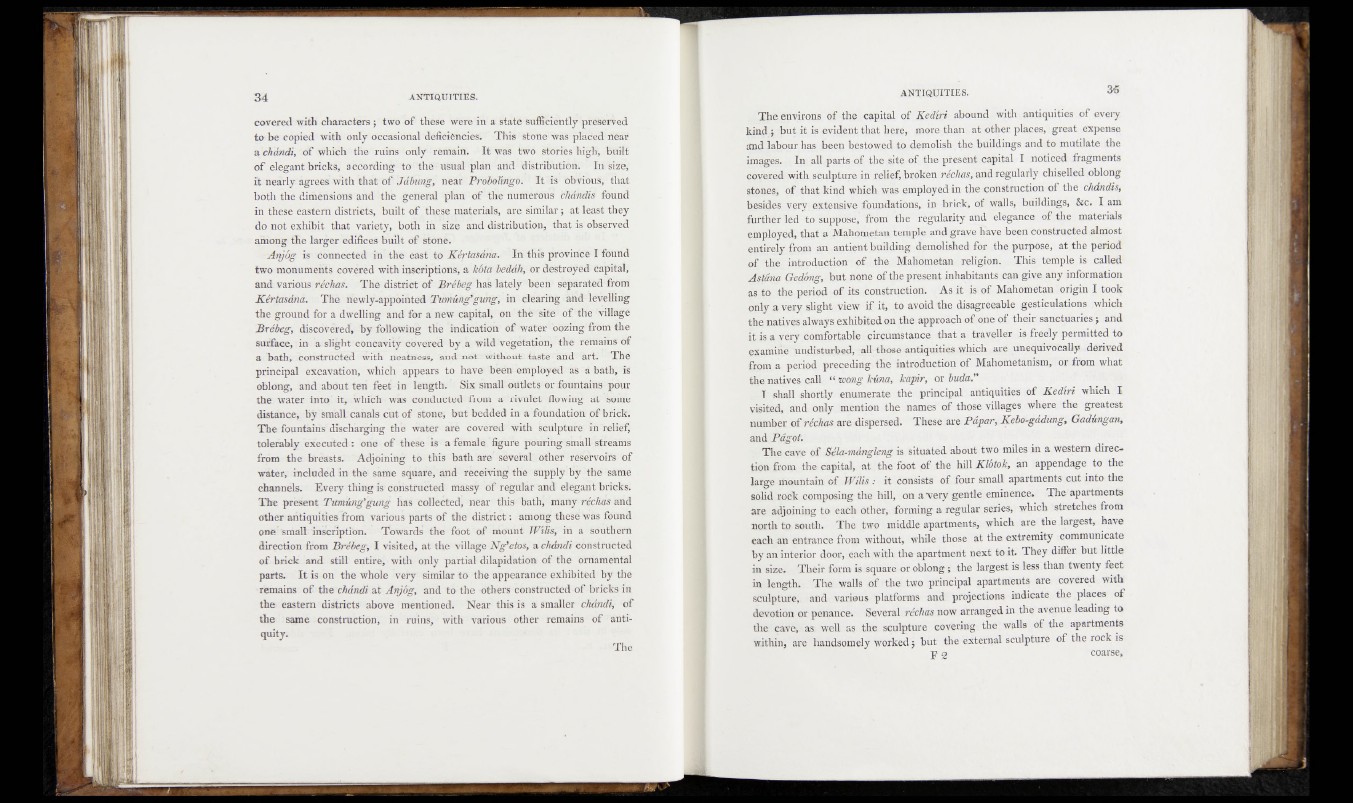
covered with characters; two of these were in. a state sufficiently preserved
to he copied with only occasional deficiencies. This stotte was placed near
a chdndi, of which • tie«'rrotes only remain. It was two stories ’high, Milt
of elegant bricks, according to the ushaT[piafi and distribution. Ih-sfisi^
ft nearly agrees’ with that of Jdbung, hear Probolingo. It is obvious, that
both the dimensions and the general plan of the numerous ckdndis found
in these eastern districts, built of.th,ese materials, are similar; at least they
do not exhibit that variety, both in size and distribution, that is observed
among the larger edifices built of stone.
Anjog is Oonnected in the east to KirtasAria. In this province1 I found
two monuments covered with inscriptions, a koia beddh, or destroyed capital,
and. variousrecAas. The district of Brebeg has lately been sepshated from
Kertasana. The newly-appointed Tumunggurig, in clearing and levelling
the ground for a dwelling and for a new capital, o n ‘the' Site of 'fHe' "village
Brebeg, discovered, by following the indication of water oozing from the
surface, in a slight concavity covered by a wild vegetation, tlM remains of
a bath, constructed with neataess, and not.' without taste and art. The
principal excavation, which appears to have bedn employed’ as a bath, is
oblong, and about ten feet in length. Six small ©iftlets ©r fountains pdur
the water into it, which was conducted from a rivulet flowing at some
distance, by small: canals cat of stone, bat bedded in a Toundatiom,6fibriek£
The fountains discharging the water are covered with Miulpture in relrefi
tolerably executed : one of these is a female figure pouring .small streams
from the breasts. Adjoining to this bath are several other reservoirs of
water, included in the same square, and receiving the supply by the satoe
channels. Every thing is constructed massy of regular and elegant bricks;
The present Tamung’gung has collected, near this bath, many nuchas and
either antiquities from various parts of the district: among these was found
one:'small inscription. Towards the foot 'of mdunt Wilis, in a southern
direction from Brebeg, I visited, at the village Nietos, a chdndi constructed
of brick and still entire, • with only partial dilapidation of the ornamental
parts. I t is bn the whole very similar to the appearance exhibited by the
remains of the chdndi at Anjog, and to the others constructed of bricks in
the> eastern districts above mentioned. Near this is a smaller chdndi,- of
the same - construction, in ruinS>'with various other remains of antiquity.
The environs of-the capital o f Kediri abound with antiquities of every
kind; ^utit is evident that hqre,, more than at other places, great expense
and labour has been bestowed-. £o demolish the-buildings and to mutilate the
images. In all parts of thetgjte of the present capital I noticed fragments
covered-with sculpture in relief, .broken r échus, and regularly chiselled oblong
stonep, of that kind which was employed in the construction of the chdndis,
besides vçrv extensive foundations,, in hrick, of walls, buildings, &c. I am
further led to suppose," from "the regularity and elegance of the materials
employed, that a Mahometan temple and grave Save been constructed almost
entirely frpm an antient building demolished for .the purpose, at.the period
of the introduction | of the. Mahometan religion. .Æhis temple is called
Astana Ged&ng,- but none of the present inhabitants can give any information
as to the period of its construction. As it-.is; pf Mahometan origin I took
only a very slight view if it, to avoid the disagreeable gesticulations which
the natives always exhibited on the approach of "one of their sanctuaries ; and
it is a very .comfortable circumstance that a traveller is freely permitted to
çxamine U n d is tu r b e d , all- those antiquities which are unequivocally derived
from a period preceding the introduction of Mahometanism, or from what
the natives call “ wong kàna, kapir, or buda."
I shall shortly enumerate the principal antiquities of Kedin which I
visited, and only mention the names of those villages ^here the greatest
number of reate are dispersed. These are Pâpar, Kebo-gddung, Gadüngan,
and Fagot.
The caye of Séla-mdngleng is situated about two miles in a western direction
from -the capital, a t . the foot of the hill Khtok, an appendage to the
large mountain of Wilis : it consists of. four small apartments cut into the
solid rock composing the hill, on a *very gentle eminence. The'apartments
are adjoining to each other, forming a regular series, which 'stfcetch.es from
north tp south. The two middle apartments, which are the largest, have
each an entrance from without, while those at the extremity communicate
by an interior door, each with the apartment next to it. They differ- but little
in suséi Their form is square or oblong ; the largest is less than twenty feet
in length. The: walls of the two principal apartments are covered with
sculpture,, and various platforms and. projections indicate the places of
devotion or penance. Several réchas now arranged in the avenue leading to
the cave*, as: weE as the sculpture covering the walls of the apartments
within, are handsomely worked ; bût the extenial sculpture of the rock is
j> g coarse,